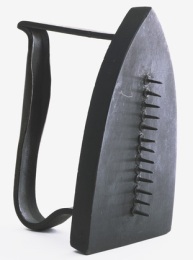
Way up there in the list of artistic concepts that have traumatized, appalled and downright confused the general population is Marcel Duchamp’s readymades. Duchamp was a surrealist if there ever was one, creating somewhere in the space between dreams and reality. His readymades were found objects that were often placed in the gallery, separated from their original context and marked with a signature. He argued that by placing these objects in a gallery setting, they were now art. It was the ultimate in sassy, challenging the notion that art objects had to be grand, meaningful works that have received the seal of approval from those in the know. Perhaps the most famous is his “Fountain” from 1917. He hung a porcelain urinal the wrong way, signed it “R. Mutt 1917” and drove the art world crazy.
Deriving from the readymade is a work we just talked about in my history of photography class: “Gift” by Man Ray. Bringing this up is making me realize I have no idea what this sculpture had to do with photography and how it fit into that day’s lesson, but I suppose that’s a concern for my grade on the midterm and not this post.

The sculpture consists of an everyday iron with 14 brass tacks glued down the center. Apparently, Man Ray made the piece the afternoon before one of his shows opened in 1921, leaving it unlisted in the catalogue. It’s typical of his work, which used unusual juxtapositions to comment on social issues — see “Le Violin d’Ingres.”
But the simplicity of “Gift” has stayed with me. Man Ray took something functional and rendered it unusable. It’s now an impossible object. Since it doesn’t serve any practical purpose, it has to be art. With this, he refutes the concept of high art as the only kind of art in a definitive way.
Beyond the obvious juxtaposition of two objects with very different uses is the name Man Ray has given the work. This is the sort of gift a spouse has to sleep on the couch for giving. But deeper than that, the work can also be seen as a comment on middle-class values. An iron is firmly the domain of a woman, who is told to derive satisfaction and contentment from running the home. She should be gentle and kind, dutifully doing her tasks. By adding the tacks, Man Ray shows the frustrations of these standards. Women at the time were entrapped by the very role they were supposed to cherish, which is reflected in the violent spikes protruding from the iron.
Of course, I’m not sure Man Ray had these feminist ideals. Regardless, the plight of women was probably not his main crusade. But art is blissfully open to interpretation, and for the modern woman, “Gift” certainly makes some interesting comments about the usefulness of the roles forced upon women for so long. So to Man Ray, I say thanks. You’ve gifted me a work I can’t get out of my head. Touche, sir.